Ring of Steall Skyrace
Posted by Ed on September 24, 2022
Summary
The Ring of Steall Skyrace is the headline event of the Salomon Skyrunning festival, a weekend-long trail running celebration in the Scottish highland town of Kinclochleven. The 28km course takes in a whopping 2500m of climbing, summiting four Munros (Scottish mountains over 3000ft) in the process.
I finished in 6:23:27, coming in 279th place out of 749 runners.
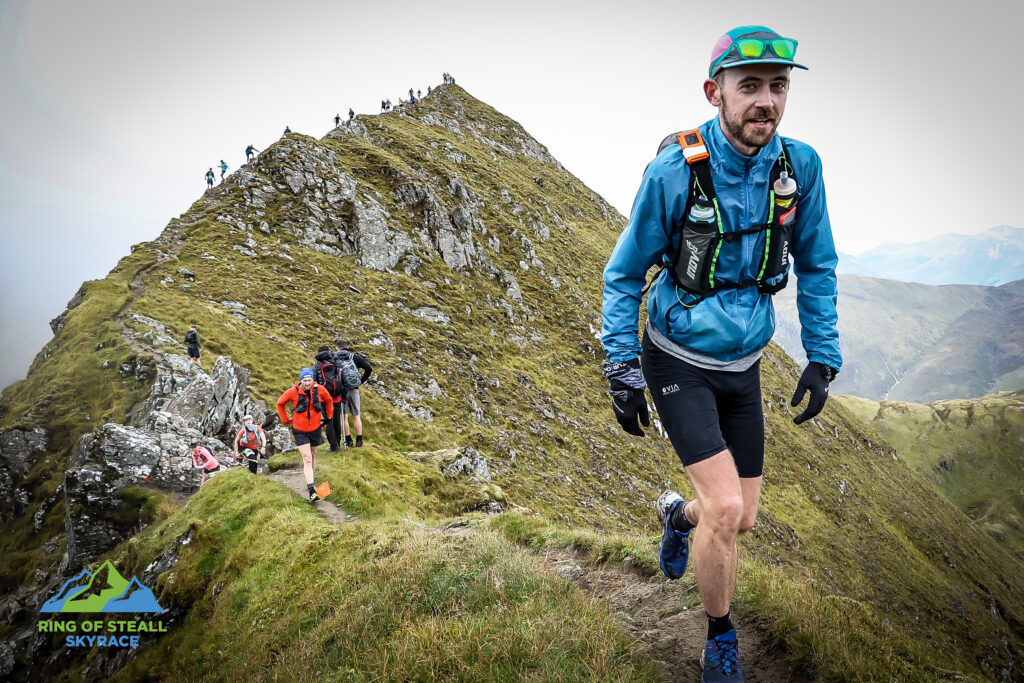
Mountains
I am not a mountaineer. I know this, because I have friends who are – and they think differently to me.
My experience with mountaineers has been that they are like engineers. They like problem solving. They like the particularities of their gear. They take safety precautions very seriously (because, in the mountains, you should.)
I’m not this way inclined. I’m a bit scatter-brained, in truth. I like the idea of mountains, but in the past have found the reality of navigating them overwhelming. Never has this ever boiled over into disaster, but I’ve come within viewing distance of some close calls – particularly when attempting to summit Taranaki in New Zealand. Less dramatically but no less seriously, in 2021, on a trip to Arran, I found myself negotiating more of a scramble than I’d bargained for ascending North Goat Fell. I got through it, but I didn’t exactly enjoy it.
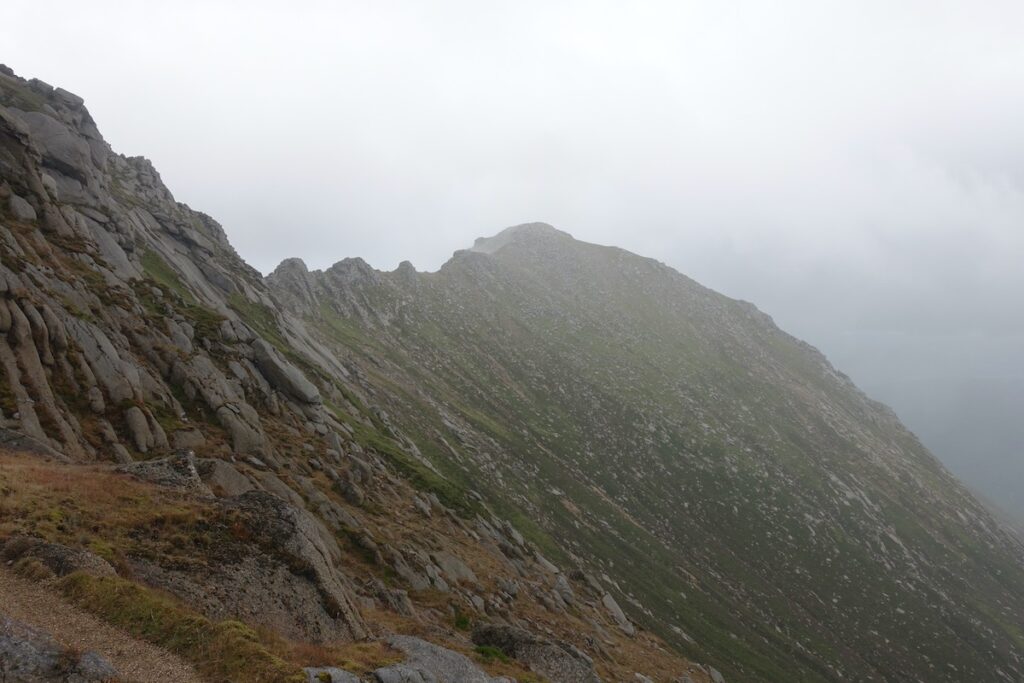
No, I’m not a mountaineer. I’m a trail runner. But I’m a trail runner who likes big hills and steep climbs. So it stands to reason that I could learn to love mountains. When I was searching for an event around which to structure my autumn season in 2022 – having failed to get into both OCC and the London Marathon – I opted to enter the Ring of Steall to see if this nascent love affair might be ready to blossom.
Pre-race
I arrived on the Friday night to register and soak in a bit of the atmosphere of the event. Surrounded by mountains on three sides, and overlooking Loch Leven to the west, Kinlochleven is about as picturesque a highland village as you could hope to find.
With over a thousand runners taking part in the Salomon Skyline event series over the course of the weekend, there was a definite buzz in the air as we collected our bibs and got our portraits snapped for the GPS tracker. I bumped into a friendly group of guys my age from London, and we exchanged tales of our woeful attempts at recreating in training anything like the kind of elevation profile we were due to be dealing with during the race.
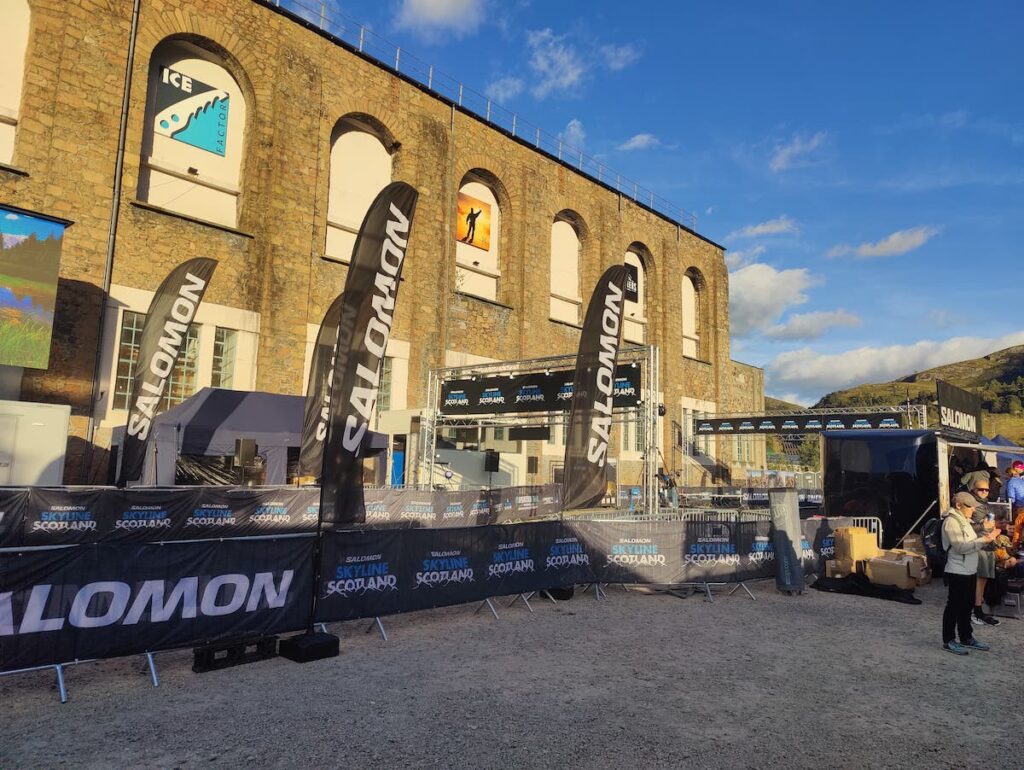
The next morning, I was afforded a leisurely start, as I was due to start my race in wave four of five, at 9:45. This gave me time to have breakfast (not normally something I bother with when a race starts at the crack of dawn) and head to the event village a good hour before my start time to watch the elites heading off.

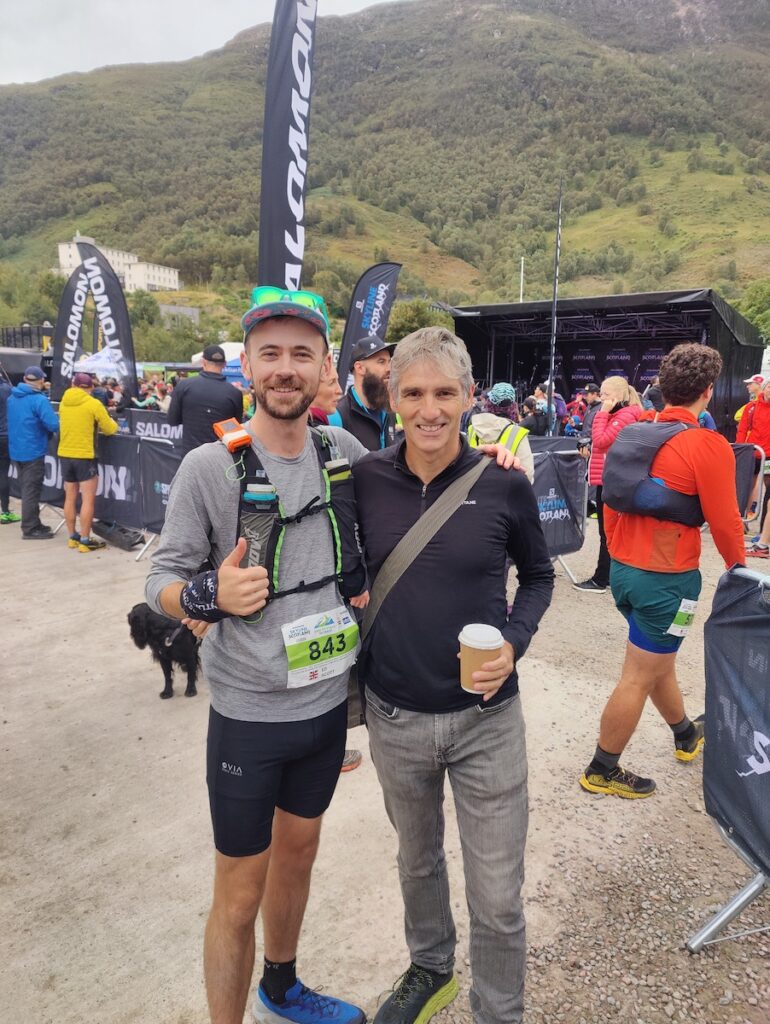
The middling weather – cloudy and around 10 degrees Celsius – meant that the variety of outfits on display was remarkable: many were clad up to the nines in long-sleeve base layers and waterproofs, with bulging packs protruding from their backs like tortoise shells; others stood in nothing but shorts and a vest, having somehow managed to cram the sizeable mandatory kit list into a bum bag.
Whilst waiting for my wave, I was pleased to bump into Stephen Cousins, he of Film My Run fame, who was up to have a crack at the Ben Nevis Ultra, which he had DNF’d twice before (on one occasion missing a checkpoint cut off by two minutes and being forced to stop, despite having four hours left to complete the remaining 10km!) He was very friendly and we chatted all things Centurion, as he’s running the 100 Grand Slam next year and I’m planning on having a crack at my first 100 on the South Downs.
Once 9:30 rolled around, I headed through the final kit check where I was asked to display my raincoat, survival bag, and waterproof trousers. Despite having inspected the kit list multiple times, it was nonetheless a slightly nerve-wracking experience. Even the seams on my raincoat were checked. Thankfully, my kit passed without a hitch, and I made my way through to the starting pen, along with the other 200 odd runners in my wave. A lone piper played a tune in tribute to the late Queen Elizabeth, and after a five second countdown, we were off.
The race
After a kilometre or so of road out of the village, we soon hit the West Highland Way, which began to climb through a lovely woodland trail up the valley wall. Quite unsurprisingly, it quickly turned into a bit of queue up the slope, but this didn’t bother me too much. There was enough room on the trail to occasionally overtake someone if it felt like they were going too slow, and at this early stage in the race, I wasn’t interested in pushing.
The trail soon broke out of the forest and into open moorland. We left behind the plush, groomed trail of the West Highland Way and continued our ascent up a muddy, boggy path that picked its way through the mottled heather. At times, the path itself, which crossed a couple of rocky streams, was more or less invisible, the course only being navigable thanks to the excellent waymarking of the organisers – that, and the hundreds of runners streaming off into the distance.
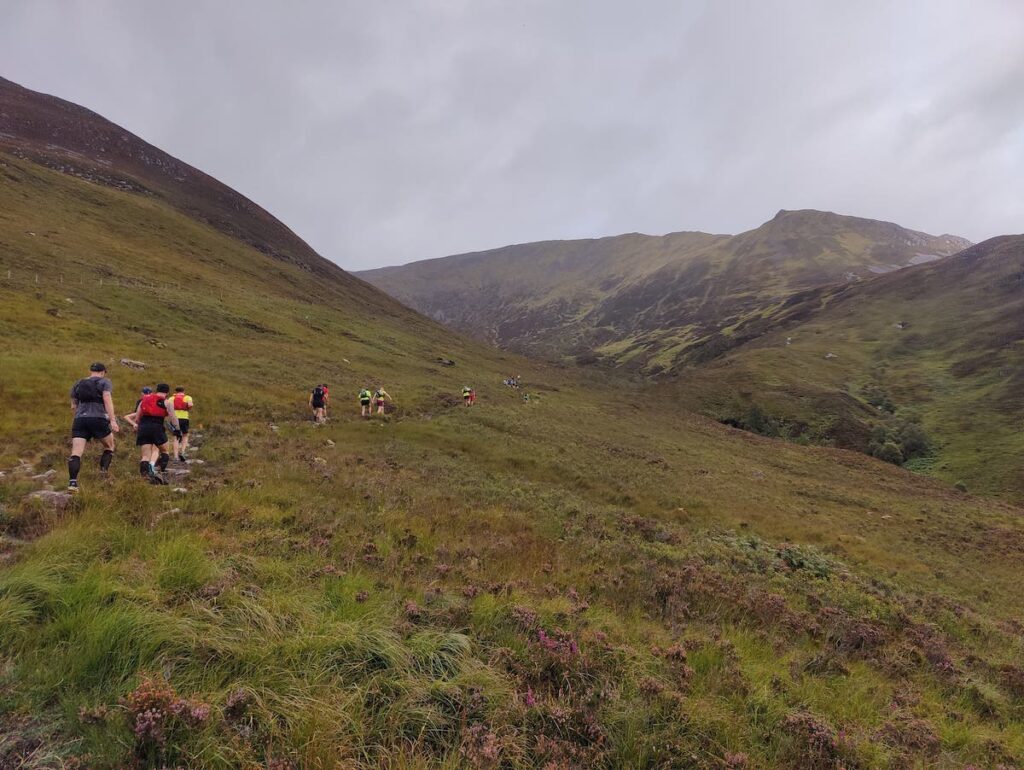
[An aside: It might seem like a downside to have so many runners taking part in a mountain event, where narrow trails make overtaking difficult, but I think it was actually quite clever on the organisers’ behalf. Having a handful of runners out in the hills dramatically increases the odds of someone becoming isolated and getting lost. There being so many runners on the course meant I could always look ahead or behind and see at least one person, even in the cloud and fog. And it made for some pretty dramatic moments, when the sheer scale of an approaching climb was made palpable by the zigzagging stream of neon-clad runners picking their way up it.]
As we climbed, I watched the numbers on my GPS watch inflate at a rate well outside what I’d ever seen in a race. We’d not yet hit the 5km mark before I clocked over 500m of elevation gain. Climbing is very much my strength, and I was pleased to continuously overtake people on this section, even catching up (I think) with some of the slower runners from the previous wave.
Eventually, after six kilometres (and 800 odd metres of climbing), we crested a ridge, where we were greeted by the sound of cowbells and a couple of enthusiastic volunteers. But the climbing was far from over – in fact, all we had done for the previous hour and a quarter was trudge our way slowly up and out of the ordinary landscape of the lowlands. Now, we were in the mountains, and the race began to take on its true flavour.
What goes up…
The Ring of Steall course is a ‘lollipop’. The same six kilometres of muddy trail the start the race is used to welcome runners back to the finish line later in the day. In between, the course completes a 16km loop around the Steall waterfall that lends the route its name.
Standing there, up on the ridge with the cowbell-ringing volunteers, the slopes of Am Bodach rolled off into the clouds to our right. This was to be the last peak of the day, many hours ahead of us. It was towards the ex-Munro Sgor an Lubhair on our left that we continued on our merry way. In the distance, miniscule runners danced along the ridgeline, revealing what lay in store for those of us behind them.
As we continued to climb, the air grew noticeably colder. I was thankful for my windproof, which I packed in addition to the mandatory raincoat, anticipating the need for a bit of lightweight protection from the elements.

After cresting Sgor an Lubhair we were finally treated to our first descent of the day, which I made an absolute pig’s ear of. As mentioned, climbing is very much my strength – being fit and light gives me an advantage, I think. But fitness has very little to do with descending, which, on steep, technical mountain trails, is all about technique. So it was that a bunch of runners overtook me on just about every descent in the race, and I suspect I lost at least twenty minutes to my poor technique.
Thankfully, though, this particular descent wasn’t too long, and soon reached one end of the infamous Devil’s Ridge, a narrow, kilometre-long ridge that, in truth, looks far worse on camera than it is in real life. It definitely wasn’t the most comfortable kilometre, but negotiating it was really just a matter of putting one foot (and occasionally a hand) in front of the other.

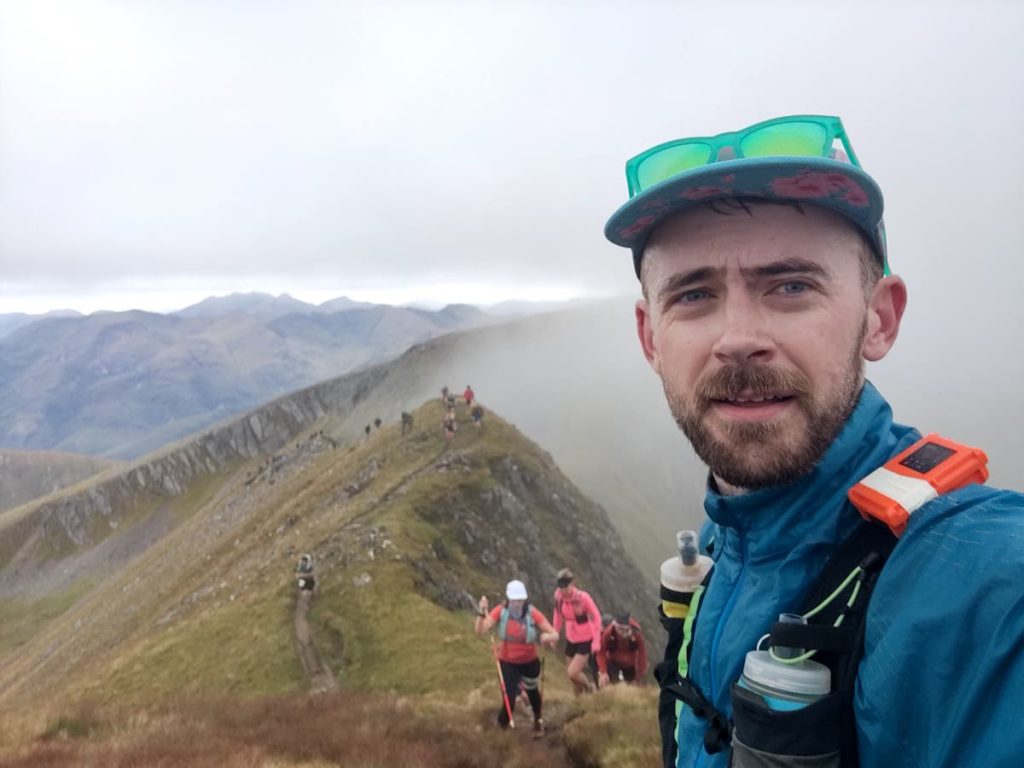
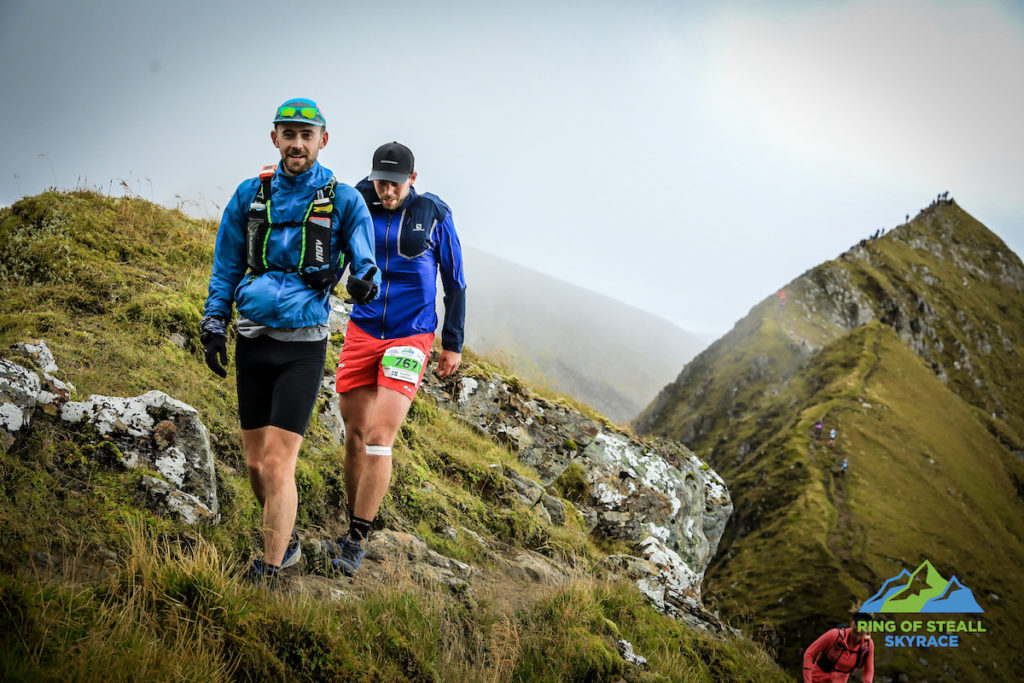
Following the Devil’s Ridge, we made our way up Sgurr a’ Mhaim, the first true Munro of the day. At the top, a handful of hardy volunteers cheered us on, one of whom was clad in a bivvy bag for warmth. It was definitely breezy up the top, not an issue for runners who only spent a few minutes up there before beginning their descent (and were pretty warm from the climb anyway), but I must salute the volunteers who spent hours up there in the wind and fog.

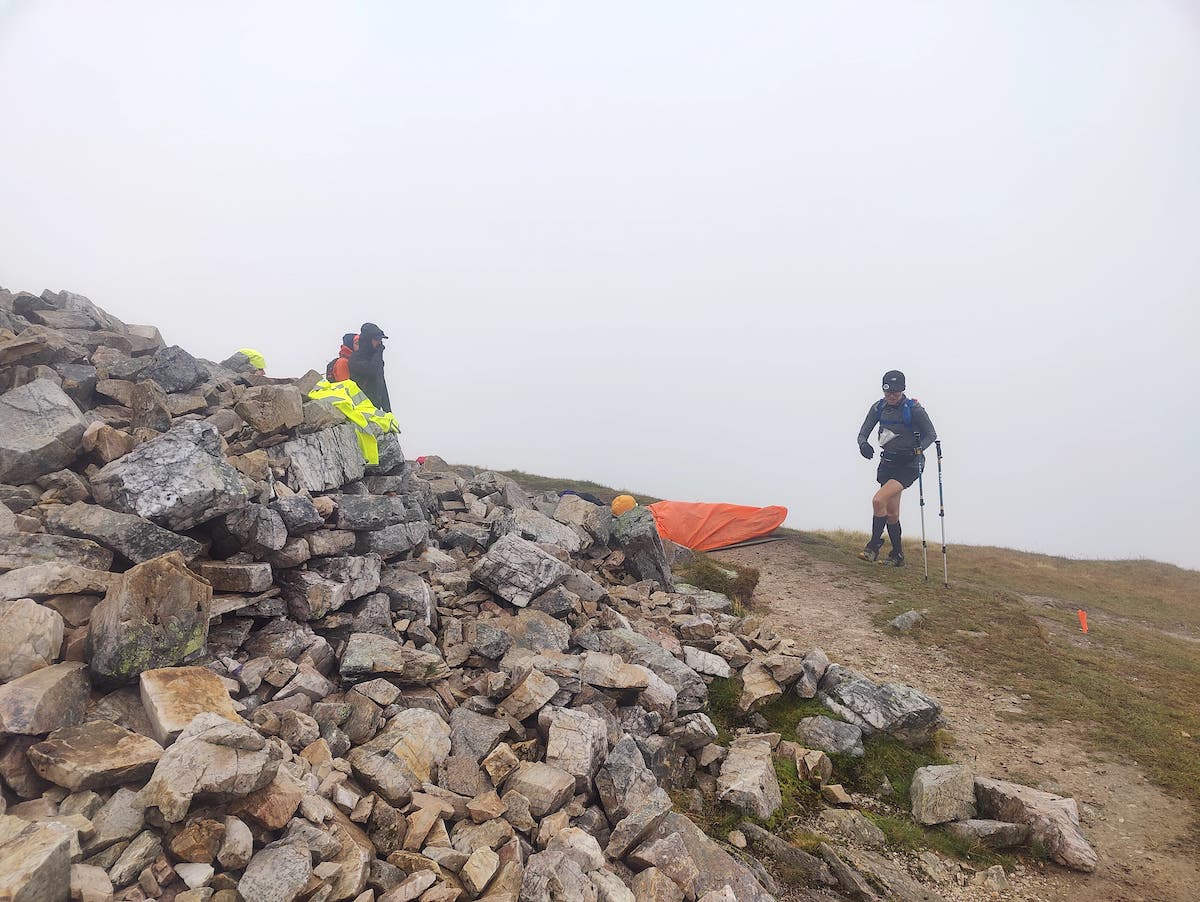
…must come down
With about half of the race’s climbing already in my legs after less than eight kilometres, I was still feeling strong, and glad to have gotten my head around the scale of the challenge somewhat. But, as I said, it wasn’t really the climbing that bothered me so much as the descending – and arguably the descent of the day was fast approaching.
Dropping 1000m in about three kilometres, the descent from Sgurr a’ Mhaim is a quad-chomping monster, the likes of which I’d never encountered. At first a loose scree slope, which is actually relatively easy to slide down, it gives way to a twisting, rutted, narrow trail embedded into the grassy hillside, which at times reaches gradients steeper than 50%.
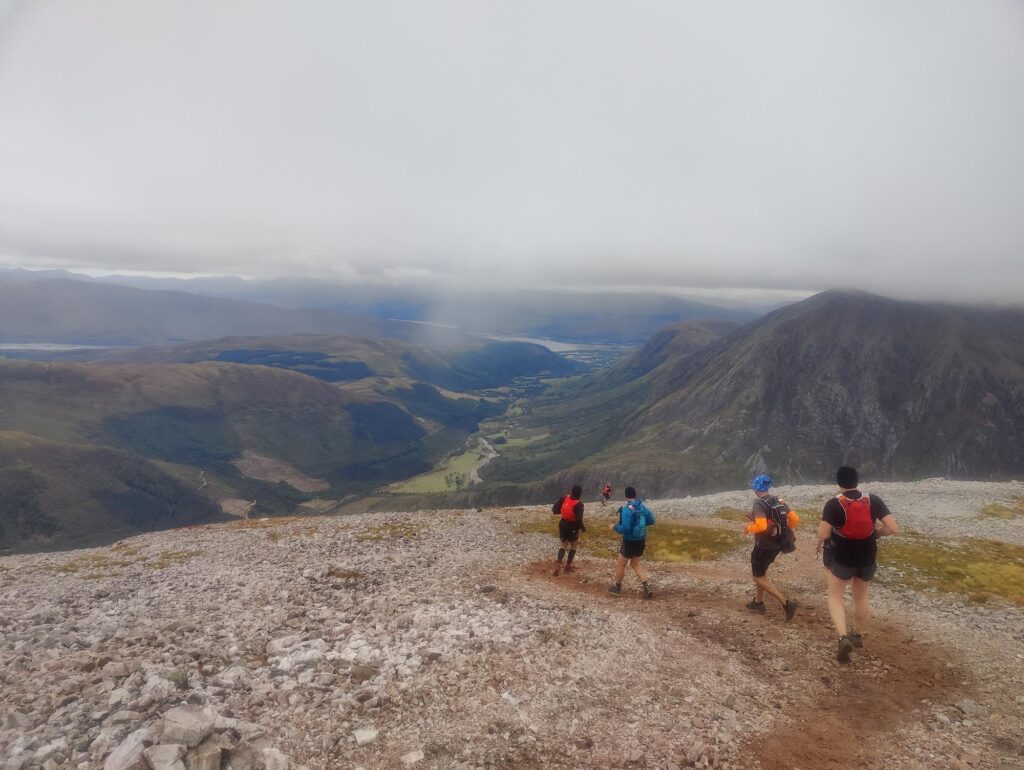
Needless to say, I did not fly down this, and many of the runners I’d outstripped on the long climb up to this point came flying past me. At times, I did my best to keep up with one or two less daredevilish descenders, but I was consistently outpaced – held back, I think, by my own internal cautiousness that wouldn’t let me trust my feet. My choice of shoes – grippy but relatively chunky Salomon Sense Ride 4s – probably didn’t help, and in hindsight, flatter, racier fell shoes might have assisted me in gripping the dirt a bit better.
After what felt like an age, the Glen Nevis valley floor seemingly getting no closer with each passing minute, the gradient finally began to ease, and gave way to a more runnable (though still very technical by southern standards) trail. Checking my watch, I noted that the last three kilometres had taken me no less than 50 minutes to tick off – surely a record downhill split for me in any race!
I passed a foreign runner, Japanese I think, who looked to be in a bit of a pickle, though I’m not sure of the particulars. He was being assisted by a small group of other runners, and after checking they were okay, I continued on – the course’s single aid station was only a few hundred metres ahead, after all. Over my shoulder, I heard the injured runner exclaim, “This course is much harder than the Mont Blanc Marathon!”
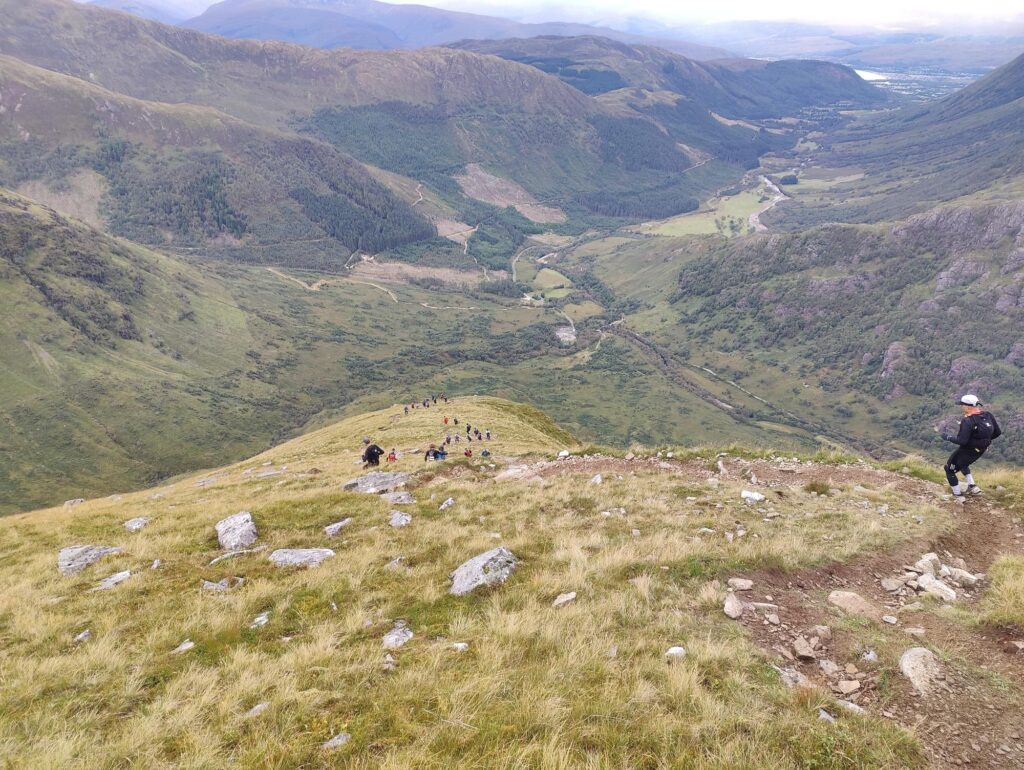
Given that the Ring of Steall consists of two large climbs connected by Glen Nevis, there is only room for the one aid station despite the race being, for most runners, an all-day affair. This emphasizes the need for self-sufficiency in terms of food and hydration, but it also means that the aid station itself is a ‘no expenses spared’ party! I was quite surprised just how many spectators and volunteers were out there, cheering people on, filling up water bottles, and providing tired runners with a veritable buffet of food and drink.
Because of the race’s steepness, going up or down, it was quite difficult to find a moment to eat, though I’d managed to ingest a few Jelly Babies and Wine Gums in between snatched breaths. Knowing that the next few miles of runnable trail provided a good opportunity to digest some calories, I wolfed down a couple of orange slices, flapjacks, and salty potatoes. I filled two of my water bottles (a third, in my waist pack, I’d not yet touched), and toped up a small 150ml flask with Red Bull for the road. Conscious about the time that can easily slip away dilly-dallying in aid stations, I headed out the second I felt like there was nothing left to be done. All in all, I think I spent about three minutes there.
The hard stuff
I made good progress through Glen Nevis, lolloping along the gentle incline at an easy but consistent pace. I overtook a lot of runners who’d chosen to walk but, knowing that many of them were likely to catch me when the next descent kicked in, I tried not to feel too smug about it. (Any smugness I might’ve had was knocked out of me when I managed to trip on a root and fall to the ground – this, after surviving the monstrous descent that came before without so much as a scratch!) It was nice to enjoy a more conventional trail race atmosphere, with tourists and hikers clapping us on. I was able to take in the beautiful scenery a bit more, too, my world not being reduced to a narrow, focused beam ahead of me, as it often was on the tops.
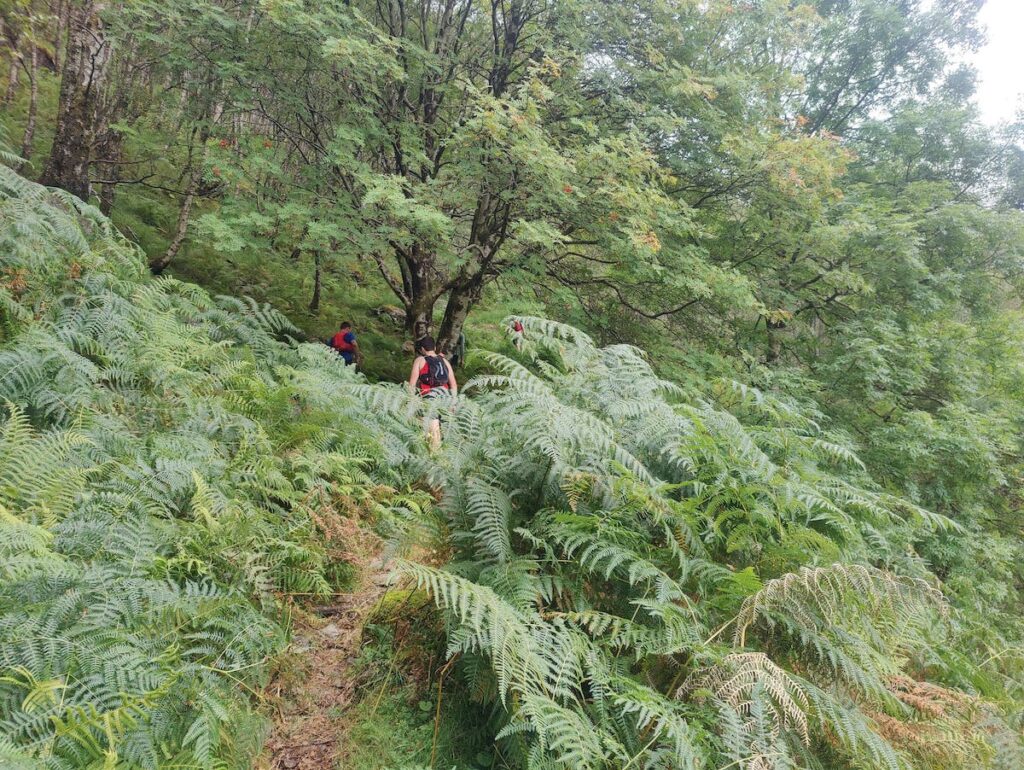
After diverting away from the main footpath and through a technical forest trail, we soon reached the Steall waterfall, which plunges magnificently down into Glen Nevis from an upland valley, the ridge of which is described by the Ring of Steall course itself.
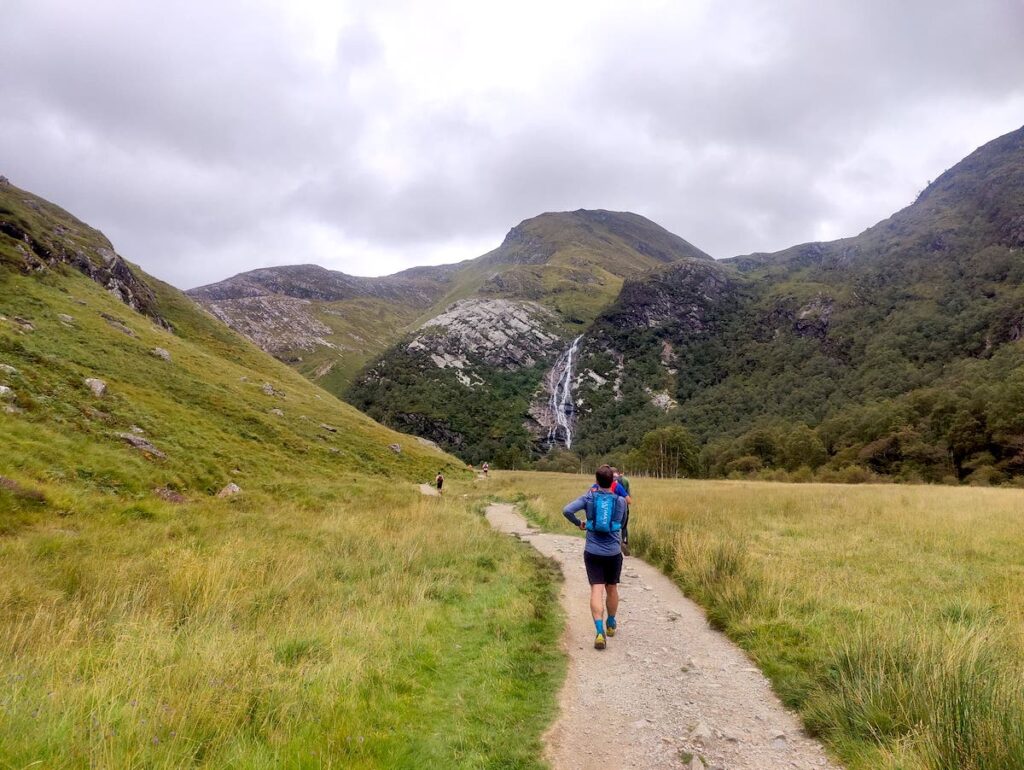
A quick river crossing brought us to the base of the next big climb of the day. Once again, the sight of runners zigzagging off into the clouds brought the scale of the ascent into focus. It was very much a case of getting on with it.

Again, I was pleased to do well on this climb, consistently overtaking people and even leading a small stream of runners who seemed happy with the pace I was setting. Switchback gave way to switchback, the air slowly but surely growing colder, the gentle safety of the lowlands unfolding into the sublime profundity of the mountains.
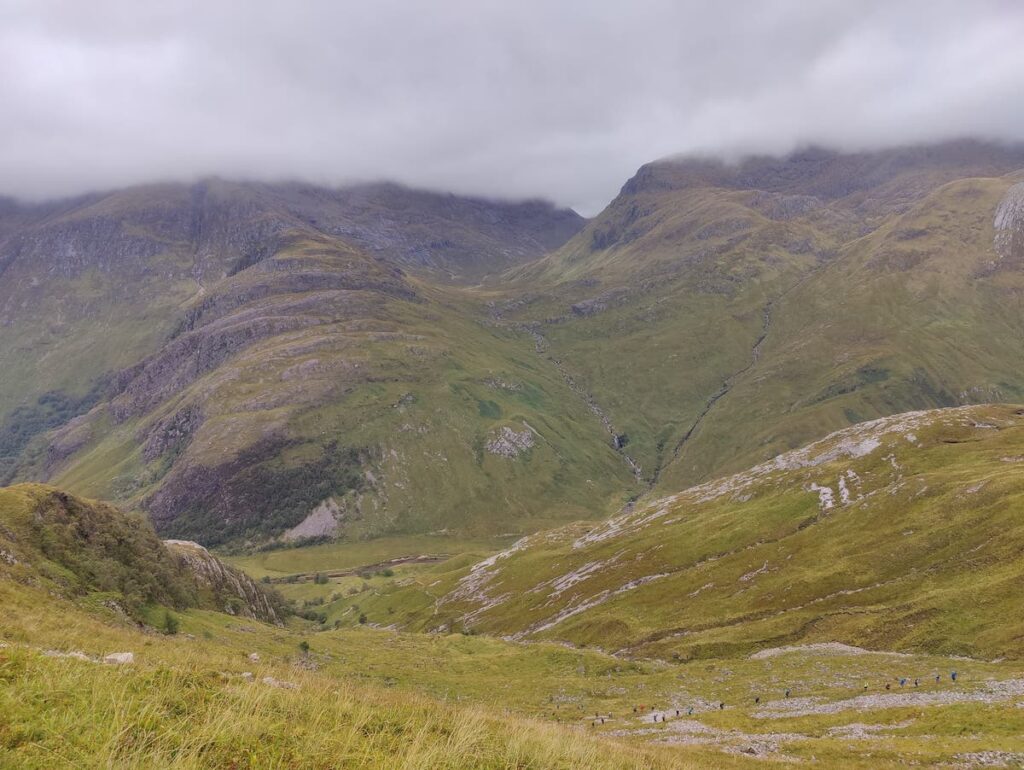
This was a climb of many false summits. No doubt the views would have been fantastic, but by the time we reached the peak of our second Munro of the day, An Gearanach, strong winds hacking at our clothing, the clouds had reduced visibility to a couple of hundred metres. This made the next stretch of the race – a scramble across the jagged ridgeline connecting An Gearanach and Stob Coire a’ Chairn – scarier than it probably actually was. It’s one thing working your way across an exposed ridge with a clear view of the drop that yawns beneath you; it’s quite another to not be able to see that drop, only the grey abyss of fog.
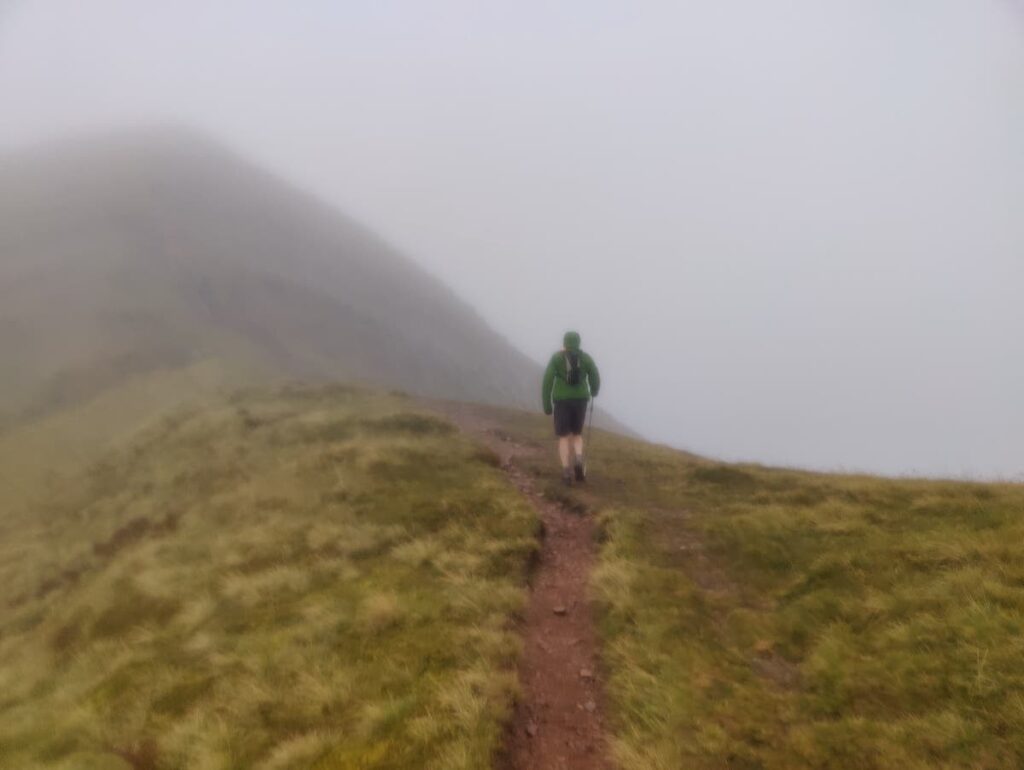
On this ridge, a runner ahead of me was experiencing a quite understandable dose of vertigo, and struggled to make progress. But whilst she didn’t traverse this section quickly, and let out more than a few swear-words and whimpers, she did so safely – more than can be said for a poor runner up ahead, who was nestled in a nook, conversing with a mountain rescue representative from beneath the bright orange tarp of an emergency shelter. I later read on the event Facebook group that helicopters had been called out at some point in the day – I don’t know if it was for this particular runner, but I do know that everybody got down safely in the end.

Encountering these two individuals imbued me with a certain steely resolve that I don’t think I’d have had if I was left to my own devices. I consider myself first and foremost a trail runner, and whilst I enjoy races with plenty of elevation, the exposed ridgelines of mountains aren’t a natural fit for me. I’ve struggled with heights since I was a kid, and in general am not a ‘type one fun’ kind of person, preferring the slow grind of a big hill to the in-your-face adrenaline rush of a craggy mountain scramble. But, seeing how much worse others were faring, I was at least confident that I could get through this section safely and without endangering others.
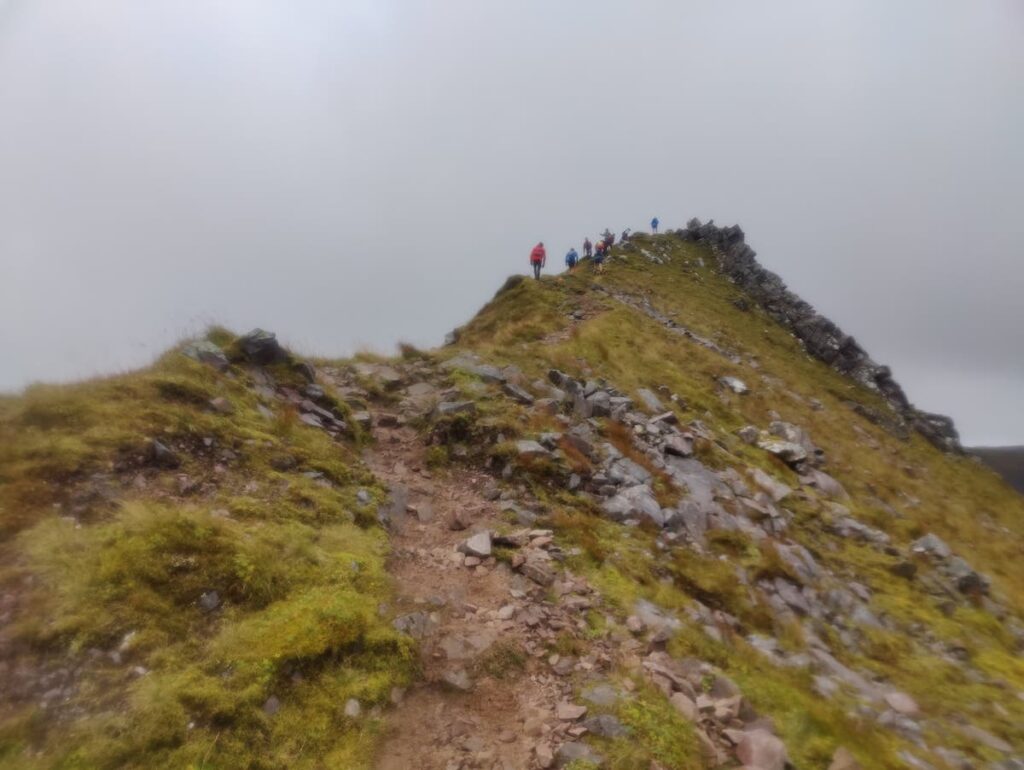
So it was that, eventually, I made it to the top of Stob Coire a’ Chairn, the third Munro of the day. Bizarrely, on the way up, a woman in flat-soled Nike trainers was walking a tiny Yorkshire terrier – which did make me wonder if I was being a bit dramatic about this whole ‘mountain running’ thing.

Again, losing time on the descent, I made my way down, my GPS watch now saying I had completed 2400 of the 2500m of elevation the race had in store. Foolishly, I trusted this reading, despite the fact that the variable weather had undoubtedly played havoc with the altimeter. Thus, when I crested the small false summit that sits between Stob Coire and Am Bodach, the last Munro on the course (and the peak whose slopes I had seen way back on that ridge at 6km), I foolishly thought that was my climbing done for the day.
You can imagine how I must have felt, then, when Am Bodach yawned into view up ahead of me.
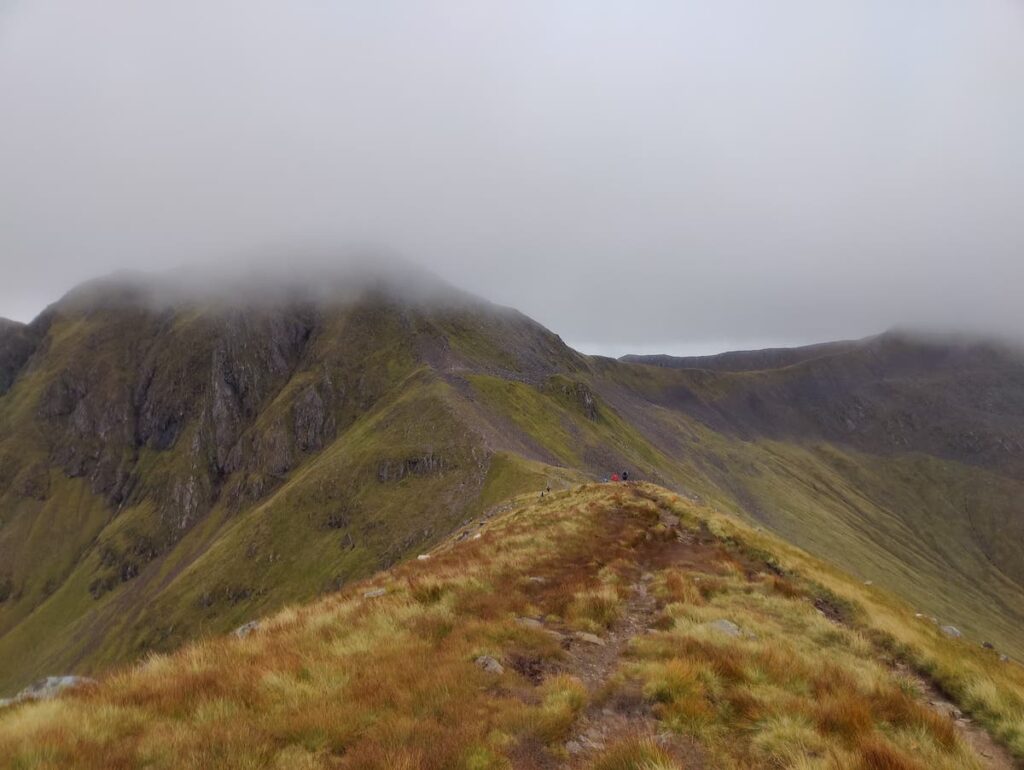
Throughout the race, a certain feeling of mild terror had been playing through my mind. It’s a feeling I’m sure anyone who has spent a reasonable amount of time in the mountains will be familiar with, particularly in less-than-ideal conditions. It’s something like awe, at the majesty and indifference of one’s surroundings. Britain being a tamed island, it’s rare to feel truly in the presence of nature at her most untrammelled – hence the predominance of bucolic interpretations of the natural world in the UK: hedgerows and wildflowers, badgers and bumble bees, rolling green hills and woodlands.
Nature is all these things, but she’s also the behemoth, the white whale, the dragon that lurches out of the abyss and eats you up for lunch. She is beauty and she is chaos, and in the mountains, never is the line between those two less clear. This blurred boundary has, I think, been what has historically turned me off from ever dabbling with ‘true’ mountaineering. I’ve been on mountains when nature has decided you are not welcome, and been humbled by such experiences. When I crested that small top and saw Am Bodach up ahead, this feeling – of awe, of terror, of humility – reached something of a crescendo. “I yield,” I wanted to say.
But, of course, that would pointless – nature can’t hear you. So I just kept going.
Homeward bound
The climb up Am Bodach was definitely the most demanding of the day. A proper scramble, requiring quite a bit of focus to coordinate after nearly five hours on my feet. A merry looking hiker was perched halfway up, undoubtedly a bit frustrated at the constant stream of runners preventing his descent, but nonetheless enjoying the opportunity to lend a few words of encouragement. “How,” I asked the runner below me (not behind me – below me) at one particularly technical junction, “did Kilian Jornet run this course in three hours?”

Upon cresting Am Bodach, I had a small break – and a Kit Kat. Then I began the long descent home.
As is always the case, the final miles of the Ring of Steall were defined by a sense of hastiness, of wanting to get the bloody thing over with. This urgency was more difficult to give in to, though, thanks to the terrain underfoot – the muddy moorland trails that we had picked our way up at the start of the day had now been churned up by thousands of feet heading up and down the mountain. My puny 4mm lugs were not enough to bite into what was essentially pancake batter, and on more than one occasion my feet rolled out from under me, though I managed to avoid all but one full-on slip.
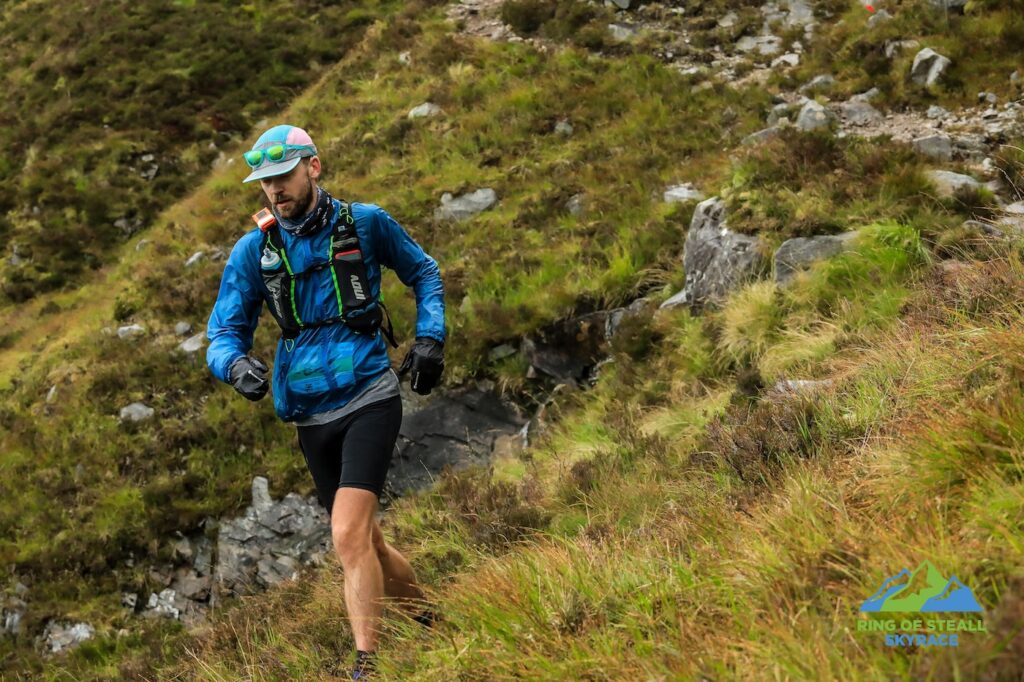
Once the steeper slopes further up the mountain gave way to the more runnable trail of the West Highland Way, I felt back in my element, and was able to put together a pretty strong descent. The mood of the pack I was with noticeably lifted as the sights of civilisation began to return – a dog walker here, a family there.
Before we knew it, we were back on the road into Kinlochleven, and a chap I’d been running with who I later learned was from Devon threw down the gauntlet and picked up the pace. Having spent the day getting my arse handed to me by old men with bum bags, I seized the opportunity to claw back a modicum of pride, and upped my cadence to match him, only to overtake him and cruise to the finish line ahead of the pack. A petty finish, perhaps, but I’ll take it!
Closing thoughts
In the end, I finished in 6:23:27, 279th out of 750-odd finishers. Though I’d flirted with the idea of going underneath six hours, it wasn’t something I’d confidently committed to, and I’m glad I didn’t run with a time in mind. The vert alone was a challenge, but the mud and technical trails presented more of a barrier than I’d anticipated. The experience was much more than a race, after all – it was a chance to enjoy a full-on mountain-running adventure with the reassurance provided by other runners and an excellently managed organisational team behind it all.
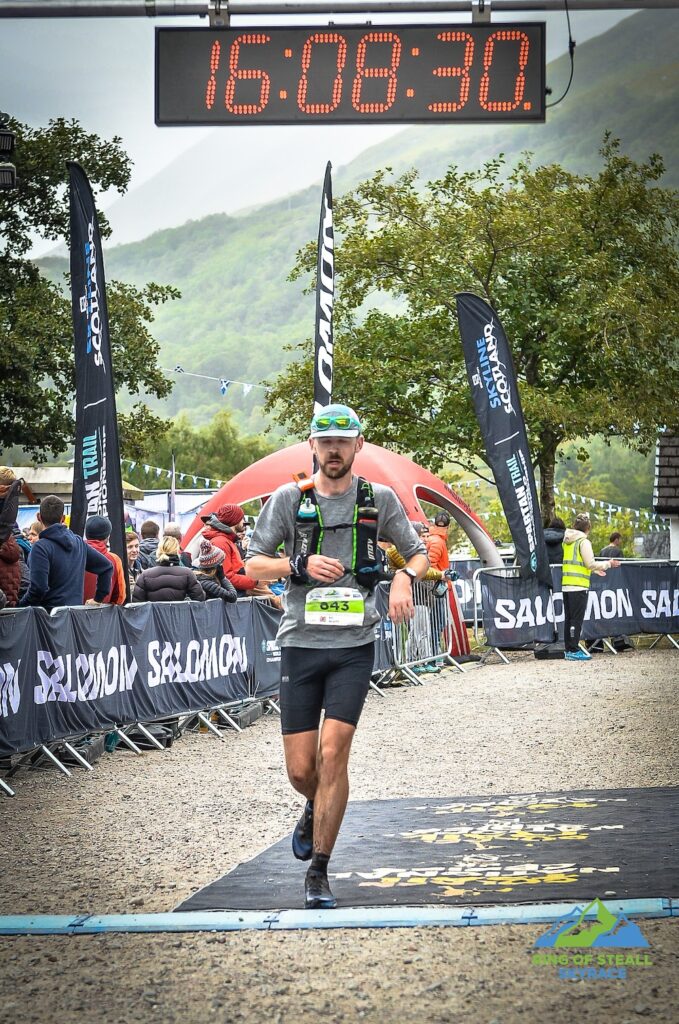
Would I do this race again? Probably, but not in a hurry! During the race itself, I was pretty confident that I was out of my depth, but on reflection, finishing inside the top third (if you count those who dropped out) is a pretty good result for a Londoner running their first mountain event. If I was able to put some time in learning to run steep, technical descents more efficiently, I’d definitely be up for returning to this event, or even considering the longer, tougher Ben Nevis Ultra. Alternatively, the less ferocious terrain offered by regions like the Yorkshire Dales or the Peak District might be worth exploring, as I suspect they lend themselves more to my out-and-out-running-oriented skillset.
For now though, my goals lie elsewhere – next year I turn thirty, and, alongside running my first 100 miler, I hope to run a sub-three hour road marathon as well. Both are big goals that exclude the possibility of indulging in more mountain running, as my focus needs to be on speed, endurance, and aerobic fitness. But I know I won’t be London-based forever, and when I’m ready, I know I’ll be returning to the mountains to try and continue to fall in love with them – terrifying though they may be.
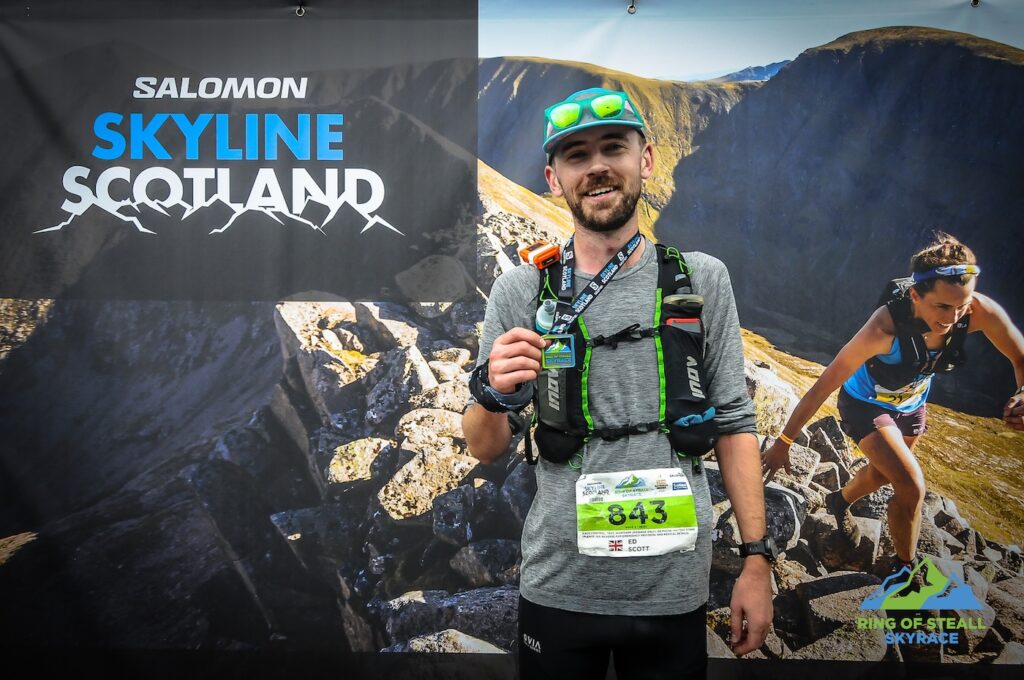
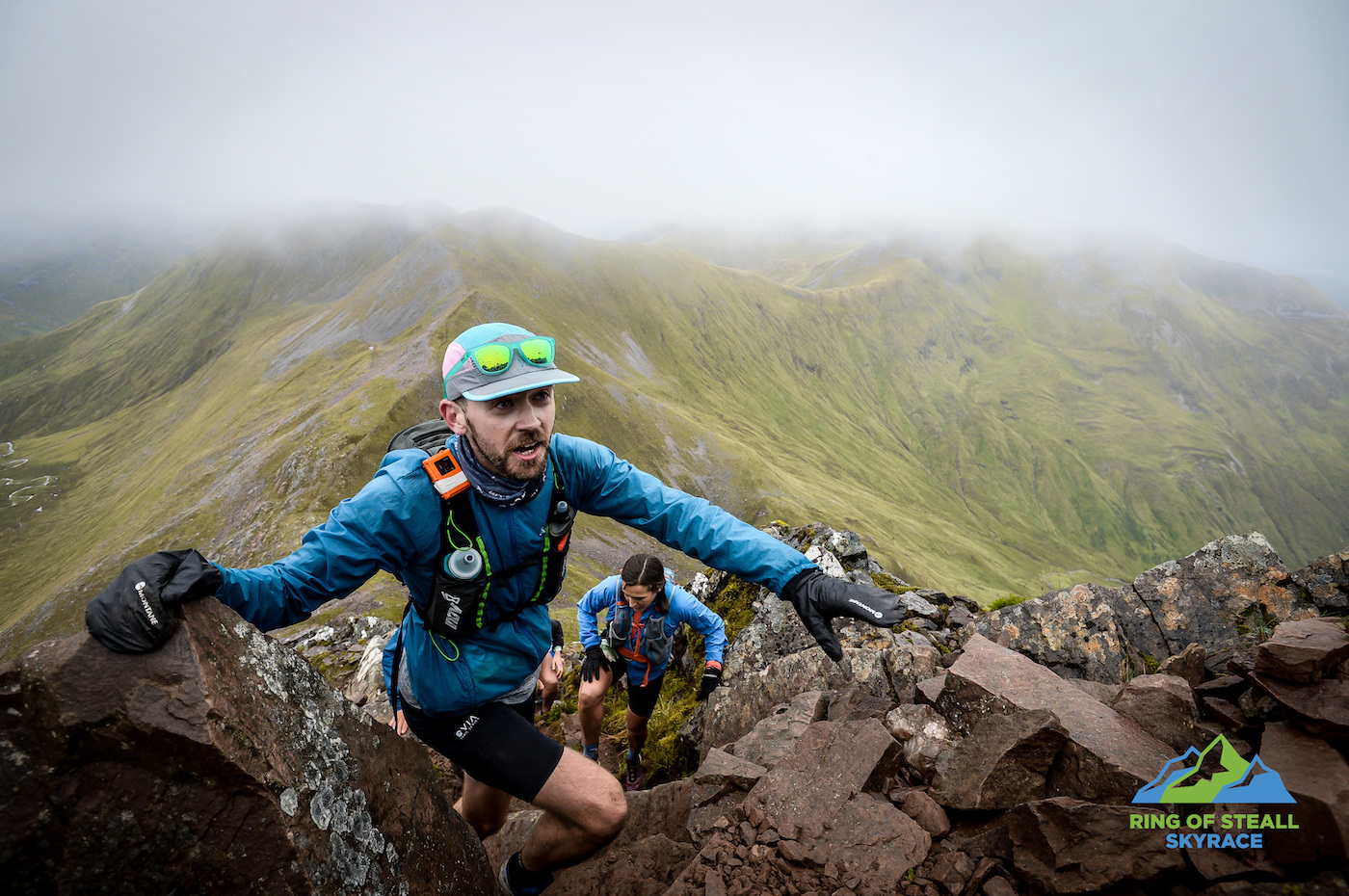
One comment on "Ring of Steall Skyrace"
Kelly
September 27, 2022 at 12:22 pm
Nice write up. It was tough wasn’t it?
Comments are closed.